Nonfiction picturebook in the Provincial Public Library of Cádiz. An analysis of the children's and young people's collection
DOI:
https://doi.org/10.24310/isl.19.2.2024.19698Keywords:
nonfiction picturebook, public library, children's and young people's collection, documentary analysis, systematic observationAbstract
This paper analyses nonfiction picturebooks in the Provincial Public Library of Cádiz to determine the place of this genre, to identify its characteristics and to explore the impact of its organisation on users. In the context of an evaluative case study, three phases were followed, combining different techniques for gathering information: 1) analysis of the collection data provided by the library on the basis of the inclusion and exclusion criteria developed ad hoc to characterise the nonfiction picturebook; 2) documentary content analysis of the non-fiction works identified in the collection; 3) systematic observation of the organisation of the nonfiction collection in the children's and young people's section. The results show that the nonfiction collection is characterised by the presence of works from earlier periods, with a representative number of works from specialised publishers that incorporate visual, artistic and interactive elements, although to a lesser extent. In addition, there were more natural science works than social science works, which is in line with the Sustainable Development Goals underlying the works analysed. Finally, an inadequate organisation and arrangement of these works in space was observed, making it difficult for users to access them in terms of visibility and mobility. Finally, we present the main strengths and weaknesses of the Fund and propose actions for improvement in order to ensure adequate gender mainstreaming.
Downloads
Metrics
Publication Facts
Reviewer profiles N/A
Author statements
- Academic society
- N/A
- Publisher
- EduVerso, Universidad de Málaga
References
Alexander, J., & Jarman, R. (2018). The pleasures of reading non-fiction. Literacy, 52(2), 78-85. https://doi.org/10.1111/lit.12152open_in_new
Angrosino, M. (2012). Etnografía y observación participante en Investigación Cualitativa. Morata.
Baró, M. (2021). Libros informativos para niños y jóvenes en España: evolución y tendencias de la producción. Bollettino As. Pe. I, 191, 36-48. https://doi.org/10.7346/aspei-022021-04
Baró, M. (2022). Los libros informativos, imprescindibles en la biblioteca escolar. Métodos de Información, 13(2), 67-90. https://dx.doi.org/10.5557/IIMEI13-N24-067090
Ben Barak, I., y Frost, J. (2020). ¡No chupes este libro! Está lleno de gérmenes. Takatuka.
Calvo, V. (2023). La lectura en la sociedad digital. En R. Tabernero (Coord.), Leer por curiosidad. Los libros de no ficción en la formación de lectores (pp. 23-35). Graó.
Fernández Moreno, A. I., García, R., Macías, C., García, F., Llobet, J., Sánchez, E., de Felipe, L., de Vicente, R., Domínguez, P., Zaragoza, R. y Bas, N. (2010). Pautas para establecer una política de colecciones en una biblioteca pública. Consejo de Cooperación Bibliotecaria. https://travesia.mcu.es/server/api/core/bitstreams/3889a27b-a40e-495d-ad2d-ff780fb4c701/content
Garralón, A. (2005). Usos del libro informativo. Resultados de una (pequeñísima) encuesta. Educación y Biblioteca, 147, 86-88. https://gredos.usal.es/bitstream/handle/10366/119177/EB17_N147_P86-88.pdf?sequence=1
Garralón, A. (2013). Leer y saber. Los libros informativos para niños. Tarambana Libros.
Gill, S. R. (2009). What Teachers Need to Know About the “New” Nonfiction. The Reading Teacher, 63(4), 260-267. https://doi.org/10.1598/RT.63.4.1
Goga N., Guanio-Uluru, L., Oddrun, B., & Nyrnes, A. (2018). Ecocritical Perspectives on Children's Texts and Cultures. Nordic Dialogues.
Goga, N. (2020). Verbal and visual informational strategies in non-fiction books awarded and mentioned by the Bologna Ragazzi Award. 2009-2019. In G. Grilli (Ed.), Non-fiction picturebooks. Sharing Knowledge as an Aesthetic Experience (pp. 51-68). Edizioni ETS.
Goga, N. (2021). A is for … awareness. Fostering interspecies awareness through nonfiction ABC picturebooks. In N. Goga, S. Hoen Iversen & A. S. Teigland (Eds.), Verbal and visual strategies in nonfiction picturebooks. Theoretical and analytical approaches (pp. 174-188). Scandinavia University Press.
Grilli, G. (2020). The artistic nonfiction picturebook. In G. Grilli (Ed.), Non-fiction picturebooks. Sharing Knowledge as an Aesthetic Experience (pp. 22-36). Edizioni ETS.
Guba, E. G., y Lincoln, Y. S. (2002). Paradigmas en competencia en la investigación cualitativa. En C. A. Dennan y J. A. Haro (Comps.), Por los rincones. Antología de métodos cualitativos en la investigación social (pp. 113-146). El Colegio de Sonora.
Herrera Morillas, J. L. (2019). Sobre la organización de espacios en las Bibliotecas Públicas del Estado de España. Revista Española de Documentación Científica, 42(4), 1-17. https://doi.org/10.3989/redc.2019.4.1610
Hollis, H. (2021). Readers’ experiences of fiction and nonfiction influencing critical thinking. Journal of Librarianship and Information Science, 55(1), 18-32. https://doi.org/10.1177/09610006211053040
IFLA. International Federation of Library Associations and Institutions (2018). Lineamientos IFLA para Servicios Bibliotecarios para Niños de 0 a 18 años. https://repository.ifla.org/bitstream/123456789/694/1/ifla-guidelines-for-library-services-to-children_aged-0-18-es.pdf
Jiménez-Pérez, E. del P. (2023). Pensamiento crítico VS competencia crítica: lectura crítica. Investigaciones Sobre Lectura, 18(1), 1-26. https://doi.org/10.24310/isl.vi18.15839
Jiménez-Pérez, E., Gutiérrez-Fresneda, R., y Diez-Mediavilla, A. (2017). Diversidad lectora. La influencia de las TIC en la forma de leer: tipología de textos digitales. En M. El Homrani, I. Ávalos y D. E. Báez (Coords.), Respuestas e intervenciones educativas en una sociedad diversa (pp. 171-179). Comares.
Kosciejew, M. (2020). Public libraries and the UN 2030 Agenda for Sustainable Development. IFLA Journal, 46(4), 328-346. https://doi.org/10.1177/0340035219898708
Laliena, D., & Tabernero, R. (2023). Picturebooks and reader training in the 21st century. An ecocritical reading of canonical works of children’s literature. Frontiers in Education, 8, 1-8. https://doi.org/10.3389/feduc.2023.1304027
Lartitegui, A. G. (2018). Alfabeto del libro de conocimientos. Paradigmas de una nueva era. Pantalia Publicaciones.
Mañà, T., y Baró. M. (2005). La colaboración de bibliotecas públicas y bibliotecas escolares. ¿Relación, cooperación o integración? Revista de Educación, núm. extraordinario, 325-337. https://www.educacionfpydeportes.gob.es/dam/jcr:0306792b-4d30-4dae-b233-1a9b08b33538/re200522-pdf.pdf
Martínez Carratalá, F. A., Miras, S., y Rovira Collado, J. (2023). Estrategias de composición del espacio visual en el álbum para la reflexión crítica. PANGEAS, Revistas Interdisciplinar de Ecocrítica, 5, 29-44. https://doi.org/10.14198/pangeas.24665
Martins, M., & Abicalil, C. (2021). Stylistic strategies in children’s nonfiction books. En N. Goga, S. Hoen Iversen & A. S. Teigland (Eds.), Verbal and visual strategies in nonfiction picturebooks. Theoretical and analytical approaches (pp. 8-21). Scandinavia University Press.
Miret, I., Baró, M., Mañá, T., y Vellosillo, I. (2013). Las bibliotecas escolares en España. Dinámicas 2005-2011. Ministerio de Educación Cultura y Deporte. Fundación Germán Sánchez Ruipérez. http://fundaciongsr.com/wp-content/uploads/2016/03/BE-estudio.pdf
Muñoz García, L. (2020). Bibliotecas sostenibles: las bibliotecas como difusoras de la agenda 2030 y los objetivos de desarrollo sostenible. Boletín de la Asociación Andaluza de Bibliotecarios, 120, 22- 37. https://dialnet.unirioja.es/servlet/articulo?codigo=7673113
Nieto, S. (1992). El “análisis de contenido” como técnica de investigación documental. Aplicación a unos textos de prensa educativa, y su interpretación mediante “análisis de correspondencia múltiples”. Revista Investigación Educativa, 10(20), 179-200. https://dialnet.unirioja.es/servlet/articulo?codigo=764558
Nikolajeva, M., & Scott, C. (2001). Images of the mind: the depiction of consciousness in picturebooks. CREArTA, 2(1), 12-36. https://search.informit.org/doi/10.3316/aeipt.113681
Nogués, M., y Calvo, V. (2023). El libro de no ficción como vehículo intercultural y educativo: análisis de El libro de los saludos. Didáctica. Lengua y Literatura, 35, 43-54. https://dx.doi.org/10.5209/dill.80090
Noritake, Y. (2021). El bosque de los hermanos. Coco Books.
Novalbos, J. (2020). ¿Aplican las bibliotecas los objetivos de desarrollo sostenible?, ¿sí pero no? Boletín de la Asociación Andaluza de Bibliotecarios, 35(120), 38-100. https://dialnet.unirioja.es/servlet/articulo?codigo=7673114
Parra Valero, P. (2022). Bibliotecas integradas o de doble uso, la última oportunidad. MÉI. Métodos de Información, 13(24), 91-108. https://dx.doi.org/10.5557/IIMEI13-N24-091108
Pena, M., Senís, J., y Del Moral, C. (2023). Estrategias de ficcionalización en las biografías de mujeres destinadas al público infantil y juvenil. Tejuelo, 37, 7-38. https://doi.org/10.17398/1988-8430.37.7
Romero Oliva, M. F., Ambròs Pallarès, A., y Trujillo Sáez, F. (2020). Hábitos lectores de los adolescentes en un ecosistema llamado escuela: factores determinantes en estudiantes de educación secundaria. Investigaciones Sobre Lectura, (13), 18-34. https://doi.org/10.37132/isl.v0i13.295
Romero Oliva, M. F., Trigo Ibáñez, E., Heredia Ponce, H., y Romero Claudio, C. (2023). Clave para caracterizar un libro de no ficción. En R. Tabernero (Coord.), Leer por curiosidad. Los libros de no ficción en la formación de lectores (pp. 73-94). Graó.
Romero Oliva, M. F., Trigo Ibáñez, E., y Heredia Ponce, H. (2021). Libros ilustrados de no ficción y formación de lectores: un análisis desde la voz de futuros docentes. Revista Ibero-Americana de Estudos em Educação, 16(3), 1695-1712. https://doi.org/10.21723/riaee.v16iesp.3.15306
Ruiz-Guerrero, L., y Molina-Puche, S. (2021). El álbum como promotor del pensamiento crítico en Educación Primaria: una herramienta para su análisis. Investigaciones Sobre Lectura, (16), 51-74. https://doi.org/10.24310/isl.vi16.12897
Saiz Pantoja, R., y Trigo Ibáñez, E. (2023). Implementación de los ODS en la Biblioteca Pública Provincial de Cádiz: claves para avanzar en el compromiso de la Agenda 2030. En P. Canto, W. Reyes, J. M. Romero y S. Alonso (Coords.), Hacia una educación basada en las evidencias de la investigación y el desarrollo sostenible (pp. 181-188). Dykinson.
Sampériz, M., Tabernero, R., Colón, M. J., y Manrique, N. (2020). El libro de no ficción para prelectores. Análisis de las claves de construcción del discurso. Cuadernos Del Centro de Estudios de Diseño y Comunicación, 124, 73-90. https://doi.org/10.18682/cdc.vi124.4418
Sampériz, M., y Margarida, A. (2023). Las tendencias del libro de no ficción en España y Portugal: un estudio exploratorio en el ámbito editorial. Tejuelo, 37, 129-160. https://doi.org/10.17398/1988-8430.37.129
Sánchez Fortún, J. M. D. A., Baldrich, K., y Domínguez, J. C. (2023). Estrategias virtuales de promoción lectora en libros de no ficción: un estudio netnográfico. Revista Colombiana de Educación, 89, 252-274. https://doi.org/10.17227/rce.num89-17433
Sánchez García, S., y Yubero, S. (2015). Función social de las bibliotecas públicas: nuevos espacios de aprendizaje y de inserción social. Profesional de la información, 24(2), 103-112. https://doi.org/10.3145/epi.2015.mar.03
Sanders, J. S. (2018). A literature of questions. Nonfiction for the Critical Child. University of Minnesota Press.
Sanjuán, M., y Cristóbal, R. (2022). Procesos emocionales de la lectura y el aprendizaje en un libro ilustrado de no-ficción y en un libro de texto. Publicaciones, 52(1), 57–77. https://doi.org/10.30827/publicaciones.v52i1.22294
Selles, A. (2021). Agenda 2030: un nuevo marco de trabajo, también para las bibliotecas. Enredadera, 36, 3-10. https://doi.org/10.20350/digitalCSIC/13937
Shenton, A. K., & Dixon, P. (2010). How Do Youngsters Use Public Libraries to Find Non-Fiction Books? The Results of a Recent Research Project. Public Library Quarterly, 23(3-4), 77-98. https://doi.org/10.1300/J118v23n03_12
Stake, R. E. (1999). Investigación con estudio de casos (2.ª ed.). Morata.
Tabernero, R. (2023). El libro ilustrado de no ficción para niños en el marco de la sociedad digital. En R. Tabernero (Coord.), Leer por curiosidad. Los libros de no ficción en la formación de lectores (pp. 45-64). Graó.
Tabernero, R., y Colón, M. J. (2023). Leer para pensar. El libro ilustrado de no ficción en el desarrollo del pensamiento crítico. Revista de Educación a Distancia (RED), 23(75), 1-26. https://doi.org/10.6018/red.545111
Tabernero, R., y Laliena, D. (2023). El libro ilustrado de no ficción en la formación de lectores: análisis de las claves discursivas y culturales para leer en la sociedad digital. Texto Livre. Linguagem e Tecnologia, 16, 1-13. https://doi.org/10.1590/1983-3652.2023.41926
Tabernero, R., y Nogués, M. (2023). Entre papeles y pantallas. Lecturas no ficcionales de libros ilustrados de ficción. Revista Colombiana de Educación, 89, 298-319. https://doi.org/10.17227/rce.num89-17429
Thanya, R., & Suganthan, C. (2023). Reading Graphic Novels from Deep Ecology: An Ecocritical Perspective. Literary Musings, 1(2), 56-63. https://literarymusings.in/assets/uploads/file-44.pdf
Trigo Ibáñez, E., Rivera Jurado, P., y Sánchez Rodríguez, S. (2020). La lectura en voz alta en la formación inicial de los maestros de educación infantil de la Universidad de Cádiz. Íkala, Revista de Lenguaje y Cultura, 25(3), 605-624. https:/doi.org/10.17533/udea.ikala.v25n03a07
Trigo Ibáñez, E., Saiz Pantoja, R., Sánchez Arjona, E., y Romero Oliva, M. F. (2022). Desarrollar el pensamiento crítico con el libro ilustrado de no ficción en el marco del tercer espacio educativo. Revista Interuniversitaria De Formación Del Profesorado. Continuación De La Antigua Revista De Escuelas Normales, 97(36.3), 71-90. https://doi.org/10.47553/rifop.v97i36.3.96690
Trigo Ibáñez, E., Sánchez Arjona, E., y Saiz Pantoja, R. (2023). Libros ilustrados de no ficción, alternativa al libro de texto: ¿deseo o realidad? Revista Colombiana de Educación, 89, 409-434. https://doi.org/10.17227/rce.num89-17368
Von Merveldt, N. (2018). Informational picturebooks. En B. Kümmerling-Meibauer (Ed.), The Routledge Companion to Picturebooks (pp. 231-245). Routledge.
Wolf, M. (2020). Lector, vuelve a casa. Cómo afecta a nuestro cerebro la lectura en pantallas. Deusto.
Young, T. A., Moss, B., & Cornwell, L. (2007). The classroom library: A place for nonfiction, nonfiction in its place. Reading Horizons, 48(3), 1-18. https://scholarworks.wmich.edu/reading_horizons/vol48/iss1/3/
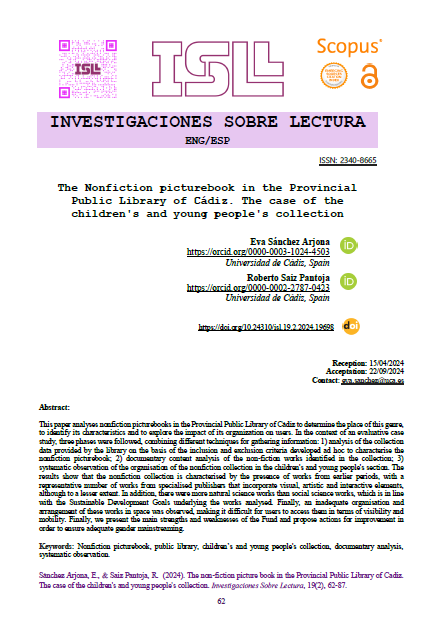
Downloads
Published
How to Cite
Issue
Section
License
Copyright (c) 2024 Eva Sánchez Arjona, Roberto Saiz Pantoja

This work is licensed under a Creative Commons Attribution-NonCommercial-ShareAlike 4.0 International License.
All contents published in Investigaciones sobre la Lectura are protected under the Creative Commons Attribution-NonCommercial-ShareAlike 4.0 International (CC BY-NC-SA 4.0) license. All about this license is available in the following link: <http://creativecommons.org/licenses/by-nc-sa/4.0>
Users can copy, use, redistribute, share and exhibit publicly as long as:
- The original source and authorship of the material are cited (Journal, Publisher and URL of the work).
- It is not used for comercial purposes.
- The existence of the license and its especifications are mentioned.
There are two sets of authors’ rights: moral and property rights. Moral rights are perpetual prerogatives, unrenounceable, not-transferable, unalienable, imprescriptible and inembargable. According to authors’ rights legislation, Investigaciones sobre la Lectura recognizes and respects authors moral rights, as well as the ownership of property rights, which will be transferred to University of Malaga in open access. The property rights are referred to the benefits that are gained by the use or the dissemination of works. Investigaciones sobre la Lectura is published in an open access form and it is exclusively licenced by any means for doing or authorising distribution, dissemination, reproduction, , adaptation, translation or arrangement of works.
Authors are responsable for obtaining the necessary permission to use copyrighted images.






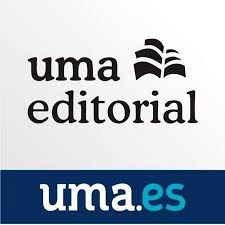
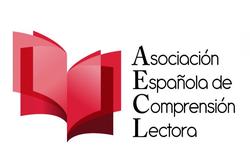
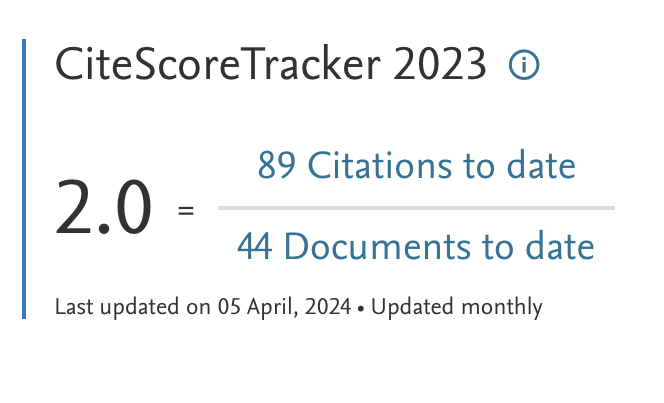
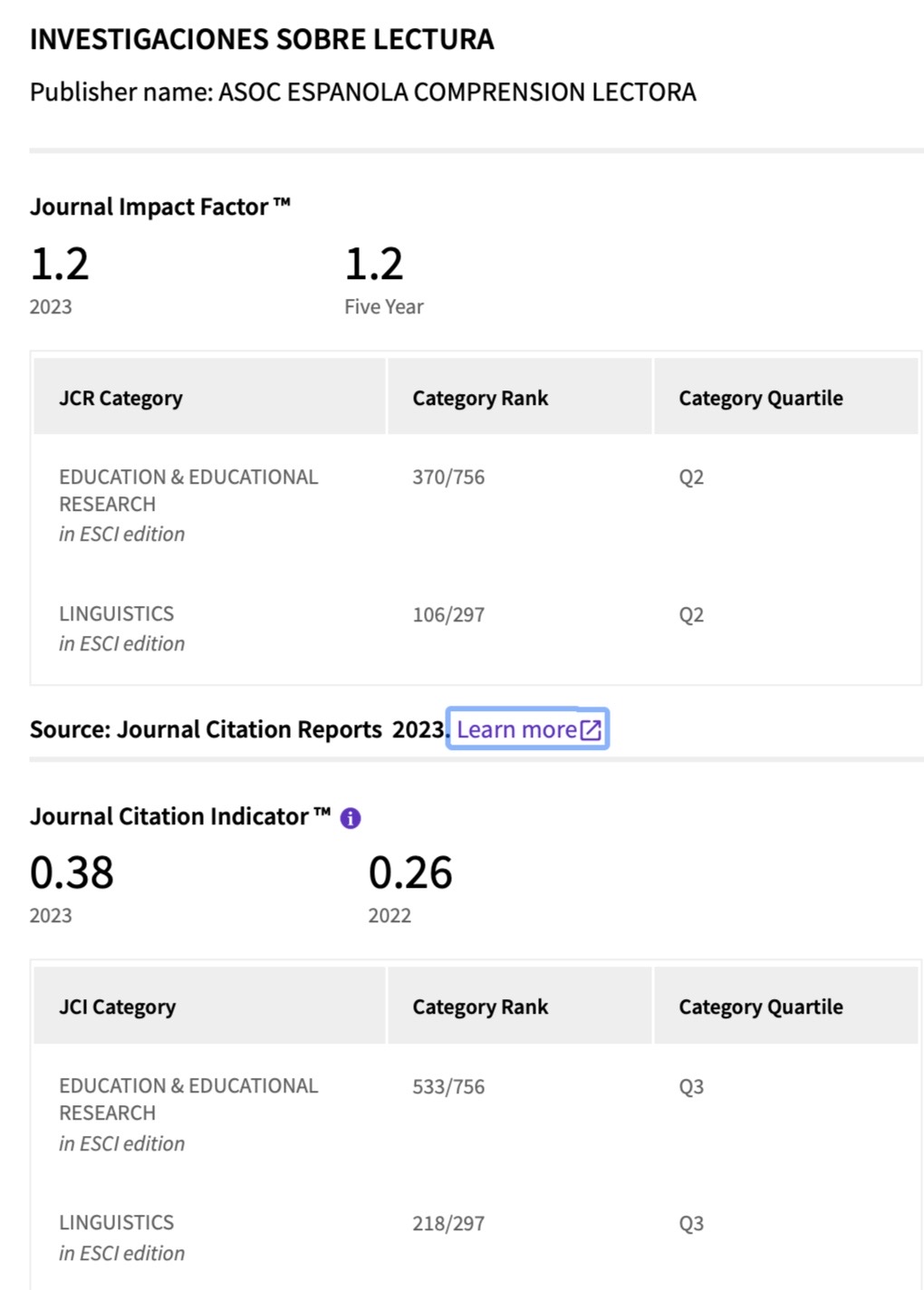

31.png)









